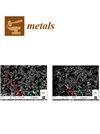Catalytic Activity Evaluation of the Molten Salt-Modified Novel Ni Electrodes for Urea Electrooxidation in Alkaline Solutions
IF 2.6
3区 材料科学
Q3 MATERIALS SCIENCE, MULTIDISCIPLINARY
引用次数: 0
Abstract
The presented paper characterized the molten salt-modified Ni electrode with excellent catalytic activity towards alkaline urea electrooxidation reaction. The electrodes were modified by electrodeposition of Al from molten salt electrolytes containing NaCl-KCl-AlF3 at a temperature of 750 °C and applied potential of −1.9 V. The porous surface was obtained by anodic polarization with a potential of −0.4 V until the anodic current was equal to 0 mAcm−2. The prepared deposits’ structure, surface morphology, and composition were analyzed using scanning electron microscopy (SEM) and X-ray diffraction (XRD). Anodic polarization was applied to assess the electrocatalytic activity and elucidate the urea electrooxidation mechanism in 1 M KOH + 0.33 M urea solution. The nanocrystalline structure, fine grain size, and microcracks on the surface of the studied electrodes contributed to their notably high electrochemically active surface area (ECSA). The cyclic voltammetry in the non-Faradaic regions of the samples shows that molten salt modification can increase the double layer capacitance of bare Ni plates by around ten times, from 0.29 mFcm−2 to 2.16 mFcm−2. Polarization of the electrodes in urea-containing KOH solution with potential of +1.52 V shows a significant difference in catalytic performance. For the bare nickel sample, the registered current density from the urea electrooxidation reaction was around +1 mAcm−2, and for the molten salt-modified one, it was +38 mAcm−2, which indicates the fact that the molten salt surface treatment can be a promising tool in tailoring the electrochemical properties of materials.熔盐修饰的新型镍电极在碱性溶液中进行尿素电氧化的催化活性评估
本文介绍了对碱性尿素电氧化反应具有优异催化活性的熔盐改性镍电极。电极的改性是通过从含有 NaCl-KCl-AlF3 的熔盐电解液中电沉积铝来实现的,电沉积温度为 750 °C,施加电位为 -1.9 V。使用扫描电子显微镜(SEM)和 X 射线衍射(XRD)分析了所制备沉积物的结构、表面形态和成分。在 1 M KOH + 0.33 M 尿素溶液中,采用阳极极化法评估电催化活性并阐明尿素电氧化机制。所研究电极的纳米晶体结构、细晶粒度和表面微裂纹使其具有显著的高电化学活性表面积(ECSA)。样品非法拉第区的循环伏安法显示,熔盐改性可将裸镍板的双层电容提高约十倍,从 0.29 mFcm-2 提高到 2.16 mFcm-2。在电位为 +1.52 V 的含尿素 KOH 溶液中对电极进行极化,结果显示催化性能存在显著差异。对于裸镍样品,尿素电氧化反应产生的记录电流密度约为 +1 mAcm-2,而对于熔盐修饰的样品,则为 +38 mAcm-2,这表明熔盐表面处理是一种很有前途的定制材料电化学特性的工具。
本文章由计算机程序翻译,如有差异,请以英文原文为准。
求助全文
约1分钟内获得全文
求助全文
来源期刊

Metals
MATERIALS SCIENCE, MULTIDISCIPLINARY-METALLURGY & METALLURGICAL ENGINEERING
CiteScore
4.90
自引率
13.80%
发文量
1832
审稿时长
1.5 months
期刊介绍:
Metals (ISSN 2075-4701) is an open access journal of related scientific research and technology development. It publishes reviews, regular research papers (articles) and short communications. Our aim is to encourage scientists to publish their experimental and theoretical results in as much detail as possible. Therefore, there is no restriction on the length of the papers. The full experimental details must be provided so that the results can be reproduced. Metals provides a forum for publishing papers which advance the in-depth understanding of the relationship between the structure, the properties or the functions of all kinds of metals.
 求助内容:
求助内容: 应助结果提醒方式:
应助结果提醒方式:


